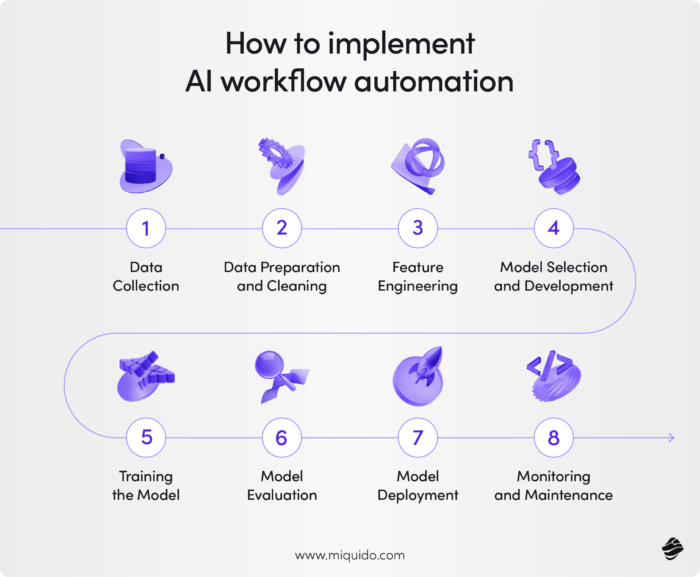

What is AI Workflow?
AI Workflow Explained
An AI workflow refers to the structured sequence of steps involved in building, training, deploying, and maintaining an AI system or machine learning model. It encompasses all the processes from data collection and preparation to model development, deployment, and continuous improvement. Each step in the AI workflow ensures that the AI system is developed efficiently and can produce accurate, actionable insights for its intended application.
This workflow is essential for creating scalable and robust AI solutions across various industries, such as healthcare, finance, marketing, and more. AI-powered systems enhance workflow efficiency and improve decision-making across these industries.
Key Stages in an AI Workflow
- Data Collection: The first step in any AI workflow is gathering relevant data. This could include structured data from databases, unstructured data like text or images, or real-time data streams. High-quality data is the foundation of an AI model’s success, as the performance of the AI system is heavily dependent on the quality and quantity of data available.
- Data Preparation and Cleaning: After data is collected, it needs to be cleaned and pre-processed. This includes handling missing values, removing duplicates, AI data anonymization, and standardizing the data format. Data normalization or transformation may also be required to make it suitable for the machine learning algorithms. This step is crucial in the AI workflow to ensure the dataset is free from noise and biases, which can negatively impact model performance.
- Feature Engineering: This step involves identifying the most relevant variables (or features) in the dataset that will influence the AI model’s predictions. Feature engineering may involve creating new features or selecting the most impactful ones from the existing data. Proper feature selection can significantly enhance the efficiency and accuracy of AI models.
- Model Selection and Development: In this phase, data scientists select the appropriate AI or machine learning algorithm for the task. The choice of algorithm depends on the problem type (e.g., classification, regression, or clustering) and the nature of the data. Common algorithms include decision trees, neural networks, or support vector machines. Model selection is a critical part of the workflow in AI since different tasks require different approaches to achieve the best results. Selecting the right AI workflow automation tool can also streamline the process, reducing costs and eliminating errors.
- Training the Model: The chosen model is trained on the prepared dataset. During this step, the model learns from the data by identifying patterns and relationships. Training involves adjusting the model’s parameters to minimize prediction errors. For complex models like deep learning networks, this step might require extensive computational resources and time. Hyperparameter tuning is often performed to optimize the model’s performance. Utilizing various AI tools can enhance the training process and improve model accuracy.
- Model Evaluation: After training, the model must be evaluated to determine how well it performs on new, unseen data. This involves splitting the data into training and testing sets and using metrics such as accuracy, precision, recall, and F1-score to evaluate performance. The evaluation step in the AI workflow ensures that the model generalizes well and doesn’t suffer from AI overfitting or underfitting.
- Model Deployment: Once the model has been trained and evaluated, it is deployed into a production environment where it can be used to make real-time predictions or decisions. The deployment phase involves integrating the model into business processes or software systems, ensuring it works seamlessly in a live environment. This is a key part of the AI workflows in industries where real-time decision-making is critical, such as in financial trading or autonomous vehicles.
- Monitoring and Maintenance: After deployment, the AI model needs continuous monitoring to ensure it performs well over time. The performance of the model can degrade due to changing data patterns, so regular updates and retraining may be necessary. In this step of the AI workflow, data scientists track the model’s predictions, re-tune hyperparameters, or retrain the model on fresh data to keep it accurate and reliable.

Importance of AI Workflows
Effective AI workflows ensure that the entire AI development process is efficient, scalable, and aligned with business objectives. Without a well-structured workflow, AI projects can become chaotic, leading to issues like poor model performance, data leaks, or failure to meet deadlines. A well-defined AI workflow enables teams to collaborate effectively, ensures data consistency, and creates a systematic approach to managing machine learning pipelines. Additionally, the benefits of AI workflow include increased productivity, enhanced operational efficiency, and improved data-driven decision-making.
- Scalability: An organized AI workflow allows teams to replicate and scale processes easily, enabling them to build more AI models or handle larger datasets without starting from scratch each time.
- Efficiency: Structured workflows make it easier to automate repetitive tasks, such as data pre-processing or model retraining, which improves the efficiency of AI teams. AI workflows enhance operational efficiency by automating these tasks, reducing human errors, and enabling faster decision-making.
- Quality Control: By following a structured workflow in AI, data scientists can ensure that the models they build meet certain quality standards, reducing errors and improving the reliability of AI systems.
AI Workflow Automation
As AI continues to evolve, many aspects of the AI workflow are becoming automated. Tools like AutoML (Automated Machine Learning) help automate the steps of model selection, training, and hyperparameter tuning. AI powered workflows enable faster time-to-market by automating routine tasks, enhancing productivity, and supporting digital transformation efforts across various departments within organizations. Workflow automation streamlines the process, allowing businesses to build AI systems more quickly and at lower costs. Automated AI workflows are particularly useful in scenarios where businesses need to deploy AI at scale, such as in retail, customer service chatbots, or large-scale fraud detection systems.
Automating workflows is crucial to enhance business agility and improve operational efficiency. By leveraging AI to automate workflows, organizations can streamline processes, respond rapidly to market demands, and reduce manual workloads, thereby facilitating faster product launches and driving digital transformation.
Example of an AI Workflow in Practice
Consider an AI-driven recommendation system for an e-commerce website:
- Data Collection: The system collects customer data, such as browsing history, purchase history, and product reviews.
- Data Cleaning: This data is cleaned to remove any incomplete records or outliers.
- Feature Engineering: Features like customer preferences, seasonal trends, and product attributes are identified as important variables. Automating complex workflows in this stage can significantly enhance productivity by leveraging AI-driven software and machine learning.
- Model Selection: A collaborative filtering algorithm is selected as the best fit for generating personalized recommendations.
- Training: The model is trained on historical data to learn the relationships between customer behavior and product preferences.
- Evaluation: The model’s performance is evaluated using metrics like precision (how often recommended items are clicked) and recall (how many relevant items are recommended).
- Deployment: The model is deployed into the e-commerce platform to start recommending products to customers in real-time. Automated workflows ensure seamless integration and real-time decision-making, enhancing operational efficiency.
- Monitoring: The system monitors the model’s performance, retraining the model as customer preferences and product inventories change.
In summary, an AI workflow is the step-by-step process that governs how AI systems are developed, trained, and maintained. Each stage, from data collection to model deployment, plays a vital role in ensuring the AI delivers accurate, efficient, and ethical outcomes. AI workflows are foundational for organizations looking to harness AI technologies successfully and ensure long-term scalability, reliability, and efficiency in their AI-driven initiatives.
Ready to discover more terms?





